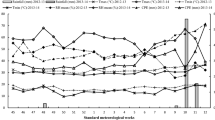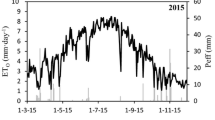Abstract
Chia is generally grown under rainfed conditions and is often under water deficit conditions during the critical period of flowering and grain filling when yield is determined. The objective of this study was to determine how intercepted photosynthetically active radiation (iPAR), radiation use efficiency (RUE), water use efficiency (WUE), and grain yield were affected by different soil water availabilities during the critical period for yield in chia. Four levels of total available water (TAW) during the critical period were obtained using supplemental drip irrigation including: T90 (90% TAW), T65 (65% TAW), T45 (45% TAW), and T30 (30% TAW). No reductions in iPAR and RUE (dry matter or yield per unit of intercepted radiation) were found between T65 and T90, which led to similar dry matter and grain yield. Water availabilities equal to or lower than 45% of TAW decreased iPAR, RUE, dry matter, and grain yield. The decrease in RUE under low TAW was associated with reductions in WUE (dry matter per mm of evapotranspiration) and in crop conductance (gc; evapotranspiration per unit of iPAR). These reductions in WUE and gc occurred, respectively, due to the greater contribution of soil evaporation to crop evapotranspiration and less transpiration per unit of intercepted radiation when TAW was 45% or lower. The use of supplemental irrigation to ensure 65% of TAW in the soil during the critical period for yield would reduce the importance of soil evaporation and increase crop transpiration by increasing crop ground cover and would lead to improved grain yields in chia.





Similar content being viewed by others
Data availability
The dataset is available upon request.
References
Allen RG, Pereira LS, Raes D, Smith M (1998) Crop evapotranspiration-Guidelines for computing crop water requirements-FAO Irrigation and Drainage Paper 56, FAO. Rome, Italy
Caviglia OP, Sadras VO (2001) Effect of nitrogen supply on crop conductance, water- and radiation-use efficiency of wheat. Field Crops Res 69:259–266
Coates W (2011) Whole and ground chia (Salvia hispanica L.) seeds, chia oil - effects on plasma lipids and fatty Acids. In: Preddy VR, Watson RR, Patel VB (eds) Nuts and seeds in health and disease prevention. Elsevier Inc, Academic Press, pp 309–315
Coates W, Ayerza R (1996) Production potential of chia in northwestern Argentina. Ind Crops and Prod 5:229–233. https://doi.org/10.1016/0926-6690(96)89454-4
de Falco B, Fiore A, Bochicchio R, Amato M, Lanzotti V (2018) Metabolomic analysis by UAE-GC MS and antioxidant activity of Salvia hispanica (L.) seeds grown under different irrigation regimes. Ind Crops and Prod 112:584–592. https://doi.org/10.1016/j.indcrop.2017.12.030
Di Rienzo J, Casanoves F, Balzarini M, Gonzalez L, Tablada M, Robledo C (2017) InfoStat Versión 2017. Grupo InfoStat, FCA, Universidad Nacional de Córdoba, Argentina http://www.infostat.com.ar
Diez J, Anuch Tiranti J, Sadras VO, Acreche MM (2021) The critical period for grain yield in chia (Salvia hispanica). Crop Pasture Sci 72:213–222. https://doi.org/10.1071/CP20432
Dinçoğlu AH, Yeşildemir Ö (2019) A renewable source as a functional food: chia seed. Curr Nutr & Food Sci 15:327–337. https://doi.org/10.2174/1573401314666180410142609
Ehdaie B, Waines JG (1993) Variation in water-use efficiency and its components in wheat: I. Well-watered pot experiment. Crop Sci 33:294. https://doi.org/10.2135/cropsci1993.0011183x003300020016x
Escobar H, Solis de Ovando L, Contreras D, Baginsky C, Arenas J, Silva H (2018) Efecto de la disponibilidad de agua de riego en el intercambio gaseoso, rendimiento de semillas, biomasa y eficiencia en el uso de agua en dos fenotipos de chía establecidos en el Valle de Azapa, Arica, Chile. Interciencia 43:55–61
Farooq M, Hussain M, Ul-Allah S, Siddique KHM (2019) Physiological and agronomic approaches for improving water-use efficiency in crop plants. Agric Water Manag 219:95–108. https://doi.org/10.1016/j.agwat.2019.04.010
Flumignan DL, De Faria R, Lena BP (2012) Test of a microlysimeter for measurement of soil evaporation. Eng Agríc 32:80–90
Gallo KP, Daughtry CST (1986) Techniques for measuring intercepted and absorbed photosynthetically active radiation in corn canopies. Agron J 78:752–756. https://doi.org/10.2134/agronj1986.00021962007800040039x
Harisha CB, Narayanpur VB, Rane J, Ganiger VM, Prasanna S, Vishwanath YC, Reddi S, Halli H, Boraiah KM, Basavaraj PS, Mahmoud E, Casini R, Elansary H (2023) Promising bioregulators for higher water productivity and oil quality of cChia under deficit irrigation in semiarid regions. Plants 12:662. https://doi.org/10.3390/plants12030662
Hay R (1995) Harvest index: a review of its use in plant breeding and crop physiology. Ann Appl Biol 126:197–216. https://doi.org/10.1111/j.1744-7348.1995.tb05015.x
Hernández M, Echarte L, Della Maggiora A, Cambareri M, Barbieri P, Cerrudo D (2015) Maize water use efficiency and evapotranspiration response to N supply under contrasting soil water availability. Field Crops Res 178:8–15. https://doi.org/10.1016/j.fcr.2015.03.017
Hernández MD, Alfonso C, Echarte MM, Cerrudo A, Echarte L (2021) Maize transpiration efficiency increases with N supply or higher plant densities. Agric Water Manag 250:106816. https://doi.org/10.1016/j.agwat.2021.106816
Kumar Jha S, Ramatshaba TS, Wang G, Liang Y, Liu H, Gao Y, Duan A (2019) Response of growth, yield and water use efficiency of winter wheat to different irrigation methods and scheduling in North China Plain. Agric Water Manag 217:292–302. https://doi.org/10.1016/j.agwat.2019.03.011
Lake L, Godoy-Kutchartt DE, Calderini DF, Verrell A, Sadras VO (2019) Yield determination and the critical period of faba bean (Vicia faba L). Field Crops Res 241:107575. https://doi.org/10.1016/j.fcr.2019.107575
Lake L, Sadras VO (2014) The critical period for yield determination in chickpea (Cicer arietinum L.). Field Crops Res 168:1–7. https://doi.org/10.1016/j.fcr.2014.08.003
Liu C, Zhang X, Zhang Y (2002) Determination of daily evaporation and evapotranspiration of winter wheat and maize by large-scale weighing lysimeter and micro-lysimeter. Agric for Meteorol 111:109–120. https://doi.org/10.1016/S0168-1923(02)00015-1
Lovelli S, Valerio M, Phillips TD, Amato M (2019) Water use efficiency, photosynthesis and plant growth of Chia (Salvia hispanica L.): a glasshouse experiment. Acta Physiol Plant 41:3. https://doi.org/10.1007/s11738-018-2795-4
Mathobo R, Marais D, Steyn JM (2017) The effect of drought stress on yield, leaf gaseous exchange and chlorophyll fluorescence of dry beans (Phaseolus vulgaris L.). Agric Water Manag 180:118–125. https://doi.org/10.1016/j.agwat.2016.11.005
Monteith JL (1972) Solar radiation and productivity in tropical ecosystems. J Appl Ecol 9:747. https://doi.org/10.2307/2401901
Muñoz LA, Cobos A, Diaz O, Aguilera JM (2013) Chia seed (Salvia hispanica): an ancient grain and a new functional food. Food Rev Int 29:394–408. https://doi.org/10.1080/87559129.2013.818014
Pereira LS, Allen RG, Smith M, Raes D (2015) Crop evapotranspiration estimation with FAO56: past and future. Agric Water Manag 147:4–20. https://doi.org/10.1016/j.agwat.2014.07.031
Pérez Brandán J, Curti RN, Acreche MM (2019) Phenological growth stages in chia (Salvia hispanica L.) according to the BBCH scale. Sci Hortic 255:292–297. https://doi.org/10.1016/j.scienta.2019.05.043
Pérez Brandán J, Curti RN, Acreche MM (2020) Developmental responses of chia (Salvia hispanica) to variations in thermo-photoperiod: impact on subcomponents of grain yield. Crop Pasture Sci 71:183−189. https://doi.org/10.1071/CP19218
Pradhan S, Sehgal VK, Bandyopadhyay KK, Panigrahi P, Parihar CM, Jat SL (2018) Radiation interception, extinction coefficient and use efficiency of wheat crop at various irrigation and nitrogen levels in a semi-arid location. Indian J Plant Physiol 23:416–425. https://doi.org/10.1007/s40502-018-0400-x
Rubí Bianchi A, Cravero SAC (2010) Atlas climático digital de la República Argentina. Instituto Nacional de Tecnología Agropecuaria, Argentina
Sadras VO, Whitfield DM, Connor DJ (1991) Transpiration efficiency in crops of semi-dwarf and standard-height sunflower. Irrig Sci 12:87–91
Seiler GJ, Qi LL, Marek LF (2017) Utilization of sunflower crop wild relatives for cultivated sunflower improvement. Crop Sci 57:1083–1101. https://doi.org/10.2135/cropsci2016.10.0856
Silva H, Garrido M, Baginsky C, Valenzuela A, Morales L, Valenzuela C, Pavez S, Alister S (2016) Effect of water availability on growth, water use efficiency and omega 3 (ALA) content in two phenotypes of chia (Salvia hispanica L.) established in the arid Mediterranean zone of Chile. Agric Water Manag 173:67–75. https://doi.org/10.1016/j.agwat.2016.04.028
Silva H, Valenzuela C, Garrido M, Acevedo E, Campos S, Silva P, Morales-Salinas L (2021) Pressure–volume curve traits of chia (Salvia hispanica L.): an assessment of water-stress tolerance under field conditions. Irrig Sci 39:789–801. https://doi.org/10.1007/s00271-021-00748-w
Sinclair TR, Muchow RC (1999) Radiation use efficiency. Adv Agron 65:215–265. https://doi.org/10.1016/S0065-2113(08)60914-1
Sosa A, Ruiz G, Rana J, Gordillo G, West H, Sharma M, Lui X, de la Robles Torre RR (2016) Chia crop (Salvia hispanica L): its history and importance as a source of polyunsaturated fatty acids omega-3 around the world: a review. J Crop Res Fert 1: 1–9. https://doi.org/10.17303/jcrf.2016.104
Tesfaye K, Walker S, Tsubo M (2006) Radiation interception and radiation use efficiency of three grain legumes under water deficit conditions in a semi-arid environment. Eur JAgron 25:60–70. https://doi.org/10.1016/j.eja.2006.04.014
Ullah H, Santiago-Arenas R, Ferdous Z, Attia A, Datta A (2019) Chapter two—Improving water use efficiency, nitrogen use efficiency, and radiation use efficiency in field crops under drought stress : A review. In: Sparks DL (ed) Advances in Agronomy. Academic Press, pp 109–157
Acknowledgements
Authors thank Mario Martinez, Federico Chocobar, and David Vargas for their field technical assistance; Juan Anuch Tiranti for his collaboration in the field measurements; and Ramiro Curti for his statistical analysis support. The study was partially funded by grants from INTA (PNIND 2013-2018 N°1108064), UNSA (CIUNSA B 2553) and the Ministry of Science and Technology of Argentina (PICT 2015 N°875). MMA and PSS are members of CONICET.
Author information
Authors and Affiliations
Contributions
JD conducted the experiments, analyzed data, prepare tables and figures and write the main manuscript. MA design the experimental idea, analyzed data and write the main article. FO conducted de experiments. JD, MA and PS reviewed the manuscript.
Corresponding author
Ethics declarations
Conflict of interest
The authors declare that they have not conflicts of interest.
Additional information
Publisher's Note
Springer Nature remains neutral with regard to jurisdictional claims in published maps and institutional affiliations.
Rights and permissions
Springer Nature or its licensor (e.g. a society or other partner) holds exclusive rights to this article under a publishing agreement with the author(s) or other rightsholder(s); author self-archiving of the accepted manuscript version of this article is solely governed by the terms of such publishing agreement and applicable law.
About this article
Cite this article
Diez, J., Orellana, F., Searles, P.S. et al. Adequate supplemental irrigation amount during the critical period for yield in chia prevents reductions in radiation capture, radiation and water use efficiencies, and grain yield. Irrig Sci 42, 541–550 (2024). https://doi.org/10.1007/s00271-023-00878-3
Received:
Accepted:
Published:
Issue Date:
DOI: https://doi.org/10.1007/s00271-023-00878-3




